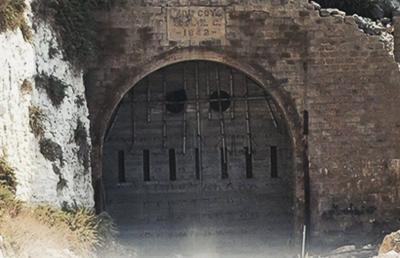The number of border disputes between Lebanon and Israel has risen to three, as the Minister of Public Works and Transport (representative of "Hezbollah") in the caretaker government, Ali Hamieh, included the file of the "Railway Tunnel" constructed by the British army in the 1940s between Lebanon and Palestine to the ongoing land and maritime border disputes between the two parties. Hamieh has effectively included the tunnel within the contested land areas between Lebanon and Israel under the title of the "Occupied Naqoura Tunnel." This includes the Shebaa Farms, Kfarshouba Hills, and the town of Ghajar (in southeastern Lebanon at the triangle border with Syria and Israel), as well as other border points and disputed maritime zones, which are subject to negotiation for border demarcation under the auspices of the United Nations and facilitated by American mediation.
During a visit to the tunnel on Saturday, Hamieh stated, "Our sovereign rights are in our decision to recover every inch of the occupied tunnel, just as our decision is to recover our land and maritime borders." The tunnel was constructed by the British army between 1942 and 1944 to facilitate rapid transit between Lebanon and Palestine, and it was closed in 1948 with the declaration of the State of Israel, according to historical documents published by local media earlier. Field sources in the south indicate that this tunnel "was closed by Israeli forces with a concrete wall earlier, and they placed barriers inside it within a geographical area located inside Lebanese territory."
The former head of the negotiating delegation regarding borders with Israel, retired General Abed Rahman Shhaity, stated that the tunnel is within Lebanese territory, and the Israelis closed it a long time ago, occupying the area where the tunnel is located. He pointed out that the Israeli side "encroaches on Lebanese territory at this point." Shhaity mentioned in a statement to "Asharq Al-Awsat" that the tunnel is directly on the Naqoura coast (Lebanon's southernmost point), while the Israeli forces have established a gate east of it "which also encroaches on Lebanese territory by about 30 meters." He clarified: "It is known that there is a border point called B1 known for its coordinates, one of 37 points demarcated with Palestine in 1923. There is no dispute on this point, but Israel now refuses to affirm and mark it and allow Lebanese access to it; the point has remained a pile of stones since 1923, and the Israeli army established the gate in front of it deep inside Lebanese territory in 2000 after the liberation of southern Lebanon."
Hamieh, a minister from "Hezbollah" in the caretaker government, opened this file during a visit to the tunnel from the Lebanese side, stating: "We are on Lebanese land that is subject to Lebanese sovereignty, and we are striving to activate the public facilities belonging to the Ministry of Public Works and Transport and increase the revenue for the Lebanese state and optimize the investment of every square meter of its properties, especially if they are within a distinguished tourist area located in the Naqoura region at the border with occupied Palestine."
He added: "For this purpose, we conducted a study on the railway tunnel constructed during World War II in 1942, revealing that its length is 695 meters, and the surrounding area is 1,800 square meters," noting that "we are now in the process of preparing specifications for launching global tenders to establish resorts and tourist facilities in this area, such as establishing a marine cable car." Hamieh stated: "As a sovereign country, we want our land borders to be complete down to the last inch of our occupied land, and our maritime borders should extend to the last drop of water in our exclusive economic zone, and we also want our rights and borders in the tunnel down to the last square meter, and we will not give up an inch of it. The Israeli enemy occupies a large part of the tunnel that we must recover, as it is subject to the properties of the Ministry of Public Works and Transport."
Lebanese parliamentary sources opposing "Hezbollah" view this visit as having opened the door to an additional border dispute alongside the known land points, confirming that from a technical perspective, "if this point is our right and is within our lands, then demanding it is necessary and occurs through Lebanese official institutions." They also pointed out in a statement to "Asharq Al-Awsat" that "in the political aspect, it seems that there is a team that believes it wants to dominate the country and subdue it in all directions." They added that the party "seeks to seize sovereign decision-making in the country, evidenced by what Deputy Muhammad Raad stated in his statement."
Meanwhile, sources close to the "Lebanese Forces" party told "Asharq Al-Awsat" that "if it is true that (Hezbollah) is trying to escalate in this border file, it will be, from a political perspective, within the framework of creating pretexts and justifications that (Hezbollah) raises to justify the continued presence of arms under the banner of what is called resistance." They added: "They will not lack means to justify the continued presence of arms under various pretexts from Shebaa Farms to the maritime dispute and the tunnel file."
The head of the "Loyalty to the Resistance" bloc (Hezbollah) Deputy Muhammad Raad stated on Sunday: "We the Lebanese people are the masters of this country, and we are the ones who draw its policies according to the interests of our children and future generations, not according to the agendas prepared by dark rooms." He added: "These people will discover that betting on the Israeli enemy to subdue our region is a futile bet and that the Israeli enemy has no place in our region, and this will be the outcome of the actions of the peoples of this region, starting with the resisting Palestinian people within, up to all the resisting peoples in our region."




